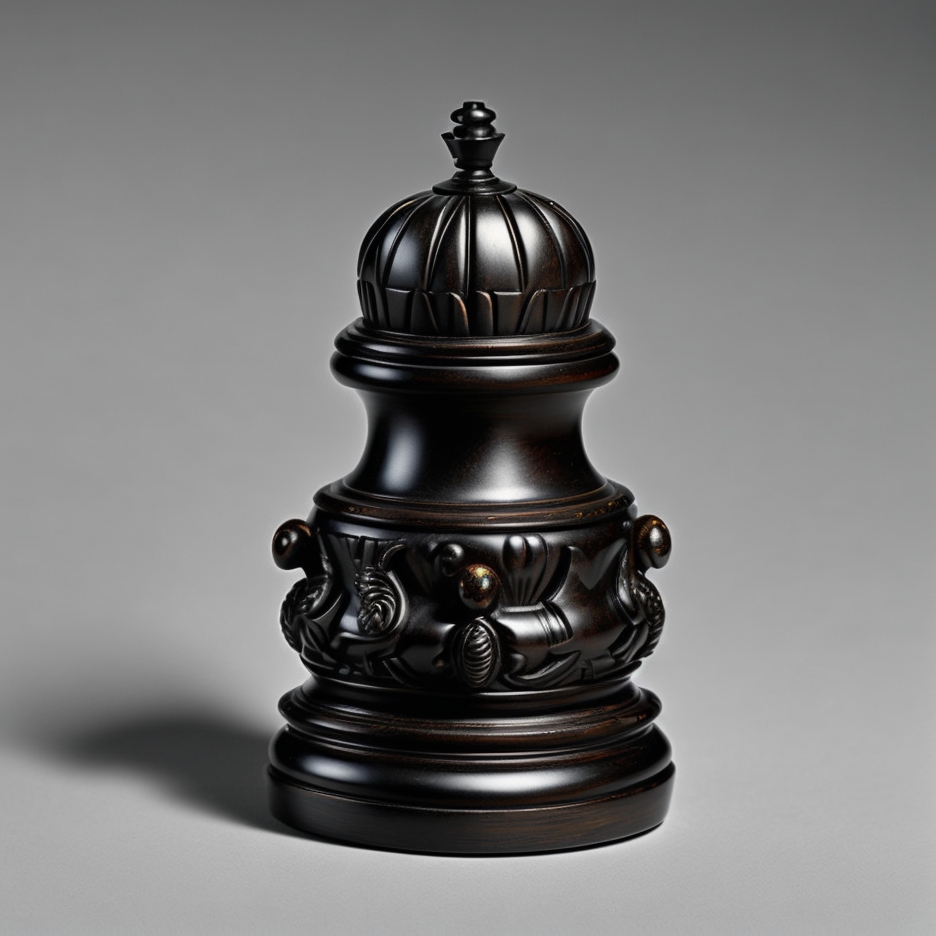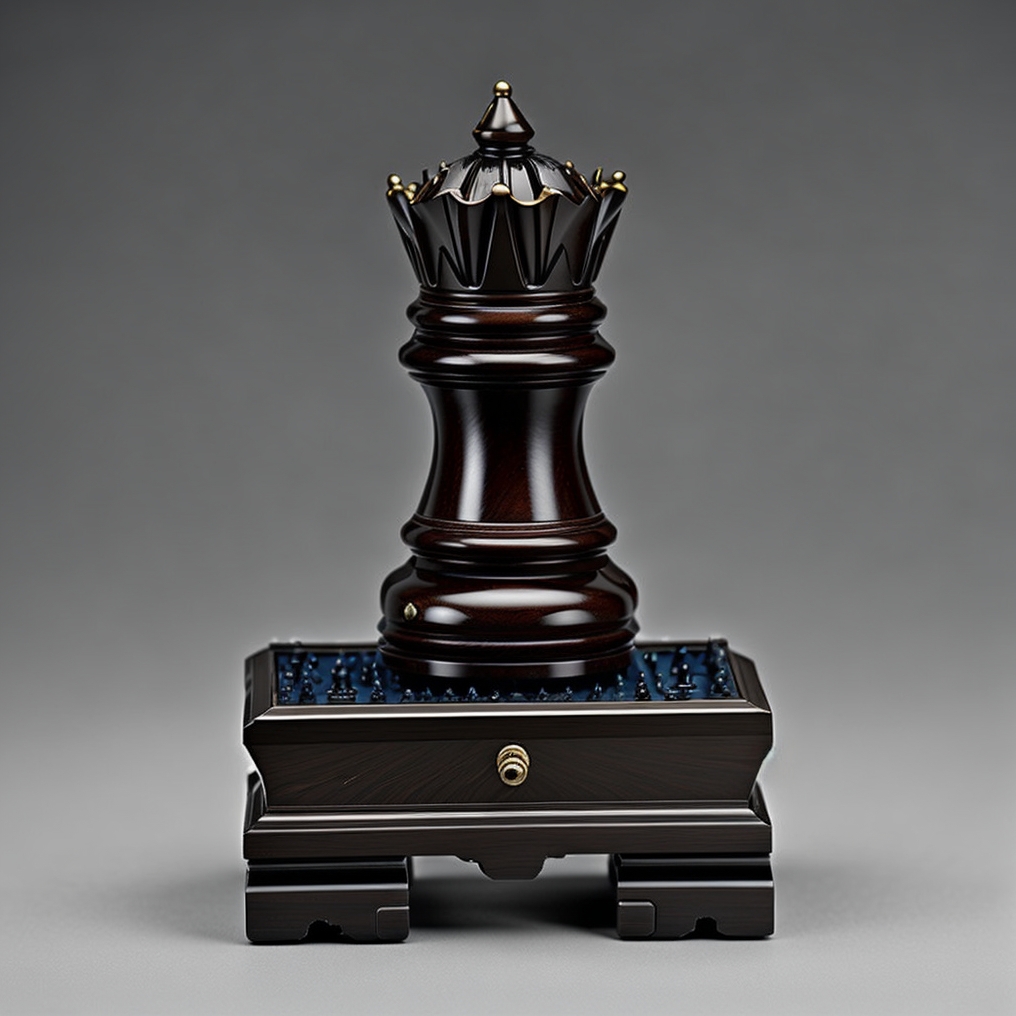Comments/Ratings for a Single Item
- Knight,
6 Archbishop, perhaps?
These pieces are not in this game. See the description of the game on this page for the available options.
 H. G. Muller wrote on Fri, Sep 29, 2023 07:10 PM UTC in reply to Bob Greenwade from 06:35 PM:
H. G. Muller wrote on Fri, Sep 29, 2023 07:10 PM UTC in reply to Bob Greenwade from 06:35 PM:The Knight is not an Ultima piece, so it probably represents a Long Leaper. A Locust/Grasshopper would have made more sense, though. Apart from the obvious King and Chameleon the others look nothing like an Ultima piece. No cigar for Leonardo.
I'd guess the most recent is the immobilizer. For the others,
- King
- Chameleon
- Coordinator
- Long Leaper
- Pincer Pawn
- Withdrawer
 H. G. Muller wrote on Fri, Sep 29, 2023 08:48 PM UTC in reply to Fergus Duniho from 08:13 PM:
H. G. Muller wrote on Fri, Sep 29, 2023 08:48 PM UTC in reply to Fergus Duniho from 08:13 PM:Most of these pieces look very much like some kind of Queen. Did you tell the AI how the pieces moved?
Daniel, you mixed up two of them. Your clue is that one of these uses a very literal, though wrong, interpretation of the name.
These pieces are not in this game. See the description of the game on this page for the available options.
Oh, I'd reached this from just viewing Comments, and thought it was from another page. I hadn't even noticed that it was Ultima! (Now, where's that "embarrassed smile" emoji?)
(I still like the horse one for a Midnighter, though.)
I redid one piece with the addition of a negative prompt to avoid an incorrect visual pun.

Most of these pieces look very much like some kind of Queen. Did you tell the AI how the pieces moved?
No, I just gave it the name of each piece as it is called in Ultima.
But I did just try it, and the results were less distinguishable from each other than what I got using names.
 Bn Em wrote on Fri, Sep 29, 2023 09:58 PM UTC:
Bn Em wrote on Fri, Sep 29, 2023 09:58 PM UTC:For me, the tall knight is the only one of these that both suggests its piece (clearly the long leaper, starting where the Orthochess knight does — though I agree with Bob that it has wider applicability) and would fit in with a Staunton‐style set; I kind of guessed the last one (of the original comment) correctly from its mild rookishness but I wouldn't be confident about it; I find the 3rd and 5th almost indistinguishable w/o direct comparison (presumably the scale would help irl)
The king is nice enough for a very ornate set, provided it had suitably ornate companions to match; the chameleon is kinda pushing it tbh (and doesn't even resemble ebony)
The visual pun is quite funny ngl; I wouldn't have said either it or its replacement is terribly suggestive though
The pincer pawn and withdrawer?
The visual pun is quite funny ngl; I wouldn't have said either it or its replacement is terribly suggestive though
Still, the "visual pun" version would go well with the Gerfod. ;)
The pincer pawn and withdrawer?
Yes to one of those and not the other.
Whether the 1963 rules include checkmate remains an open question until someone gets ahold of the 1963 rules and checks. While the Zillions-of-Games file does treat capture of the King and not checkmate as the winning condition, it also says it is based on the original rules, and these would be the 1962 rules we can read on Abbot's website. Concerning Abbott's four Ultima puzzles, he describes the first one as "Mate in 1", and he describes the other three as "Mate in 2".
However, he says of these:
This follows the conventions of chess problems, even though in Ultima the object is to capture the king, not achieve check mate.
Notably, he is saying this within the context of having tested his puzzles with Zillions-of-Games, and this is the rule programmed into Zillions-of-Games. Zillions-of-Games claims to be based on the original rules. Since these rules say the game is won through capture of the King, and they do not explicitly mention checkmate, they could be interpreted to not include checkmate. It was presumably Mark Lefler or Jeff Mallett who programmed this interpretation of the original rules. However, the 1962 article on Ultima says "The same rules for declaring check apply as in chess." How are we to make sense of this if checkmate is not part of the game? Additionally, it ends with the sentence "We are especially interested in discovering the minimum number of pieces needed for checkmate." If checkmate was not part of the original rules, it would not make much sense to say this. So, it would have been valid to understand these rules as including checkmate, and Lefler or Mallett may have made a mistake, which Abbott repeated without accurately remembering his own rules.
Around the same time that Ultima appeared in Zillions-of-Games, David Pritchard published the rules in The Encyclopedia of Chess Variants and in Popular Chess Variants. In both of these, he claimed the object was checkmate.
In the 1968 rules, Abbott explicitly mentions that the game is won through checkmate, and this comes after a paragraph in which he said "The object of the game is to check the enemy king." Given the context, this sentence does not imply that the game is not won through checkmate, and accordingly, the similar sentence in the original rules, "The object of the game is to capture this king", may not have been intended to deny that the game is won by checkmate.
Given that checkmate may have been part of the original 1962 rules and was definitely a part of the revised 1968 rules, it's reasonable to expect that it was also part of the 1963 rules.
At this point, we probably have two traditions concerning the rules of Ultima. We have those who followed Pritchard in treating checkmate as a winning condition, and we have those who followed Zillions-of-Games in making capture of the King the winning condition.
 H. G. Muller wrote on Sun, Oct 1, 2023 08:30 PM UTC in reply to Fergus Duniho from 08:05 PM:
H. G. Muller wrote on Sun, Oct 1, 2023 08:30 PM UTC in reply to Fergus Duniho from 08:05 PM:Checkmate still exists in games that finish by King capture, as the condition where it is impossible to avoid such capture on the next move. It just doesn't terminate the game. Since at any serious level of play people would not blunder away their King, the only way to capture it would be by first achieving checkmate (or stalemate). So one could say that the goal is to achieve checkmate, so that you can then forcibly capture the King. 'Goal' doesn't necessarily mean terminating condition of the game; you can have many different strategic goals. So I don't see a very large contradiction here.
That it would be mandatory to declare check doesn't mean that it is mandatory to resolve it. Of course not resolving it means your King will get captured, and that sort of makes it mandatory enough for most players, even when the rules do not strictly demand it. The fact that check has to be declared makes it even less likely they would allow the capture by oversight. (Of course they could still move themselves into check by mistake; they would receive no warning against that.)
The special status of check is not really fundamental; it is a consequence of the peculiar way that Chess handles illegal moves. In Shogi any illegal move counts as a loss, and then it makes no difference at all whether moving into check is forbidden, or just a bad move that gets your King captured. In Chess it would decide whether you have to take back the move that exposed your King, and continue the game from there, or that the opponent can capture it for the win.
I got the 1963 edition of Abbott's New Card Games, and it says the same thing with the same words as the 1968 edition concerning the object of the game. The object is checkmate or stalemate in both the 1963 and 1968 editions. Further details are in the body of the page.
Would someone be able to convert the following pieces from the Alfaerie Animals set to SVG? These are the only pieces from that set not yet available as SVG.
The other pieces are already available:








I don't know about any of those, but I have managed to replicate my Okapi into SVG if you want it. (It's just the Kangaroo, with a couple of black stripes across the bottom.)
No, the Kangaroo is one of the pieces that is already available as SVG.
But the Okapi is not.
But the Okapi is not one of the pieces used in the game.
I was meaning, just in general.
I wasn't asking in general, though.
 H. G. Muller wrote on Thu, Nov 2, 2023 01:16 PM UTC in reply to Fergus Duniho from Wed Nov 1 05:59 PM:
H. G. Muller wrote on Thu, Nov 2, 2023 01:16 PM UTC in reply to Fergus Duniho from Wed Nov 1 05:59 PM:OK, I created the following SVG:
- pincerpawn
- lizard
- windmill
- princess
- block
- medusa
- gorgona
- crookedbishop
- reflectingbishop
25 comments displayed
Permalink to the exact comments currently displayed.

 and
and 
 and
and 
 and
and 
My eye:
1. King. Suitable mainly for display.
2. Chameleon. Suitable mainly for display.
3. Don't recognize, but I'd play with this one.
4. Knight, though it could be used as a longer-range alternate Knight such as a Nightrider or Midnighter. Good for either play or display.
5. Don't recognize, but good for play. (I might use that as a Berolina.)
6 Archbishop, perhaps? (It looks like it could be a decent Inquisitor or Kuhani, actually.) Another one suitable for either play or display.